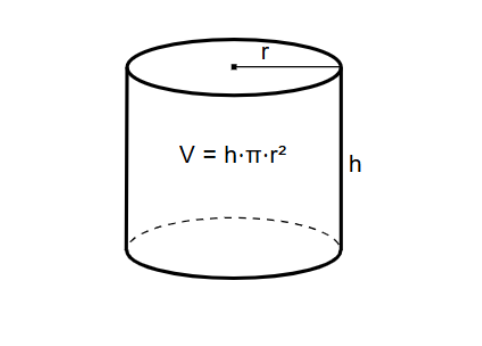1. What is a Cubic Inches of a Cylinder Calculator?
Definition: This calculator computes the volume of a cylinder in cubic inches, given the height \( h \) and either the radius \( r \) or diameter \( d \). A cylinder is a three-dimensional shape with two parallel circular bases connected by a curved surface. The calculator allows inputs in various units (inches, feet, yards, cm, m), defaulting to inches, and provides the volume in cubic inches with options to convert to other units (cubic feet, cubic yards, cubic cm, cubic m).
Purpose: It aids in practical applications by calculating the volume of cylindrical objects, useful in fields like engineering, automotive (e.g., engine displacement), and storage for determining the capacity of containers or pipes.
2. How Does the Calculator Work?
The calculator uses the following formulas:
- If diameter is given: \( r = \frac{d}{2} \)
- Volume: \( V = \pi r^2 h \)
Steps:
- Select whether to input the radius or diameter.
- Input the height \( h \) and the radius \( r \) or diameter \( d \) with their units (default: inches).
- Validate that both inputs are positive.
- Convert the inputs to inches for calculation.
- Compute the radius if diameter is given, then calculate the volume \( V = \pi r^2 h \) in cubic inches.
- Convert the volume to the user-selected unit (default: cubic inches).
- Display the result to 4 decimal places.
3. Importance of Cubic Inches of a Cylinder Calculations
Calculating the volume of a cylinder in cubic inches is essential for:
- Automotive: Determining engine displacement for performance analysis, often measured in cubic inches.
- Manufacturing: Designing cylindrical components like pipes or containers, requiring unit conversions (e.g., inches to cm).
- Storage: Estimating the capacity of cylindrical containers, such as fuel tanks or bottles.
4. Using the Calculator
Examples:
- Example 1: Height \( h = 10 \) in, Radius \( r = 2 \) in, Volume in cu in
Volume: \( V = \pi \times 2^2 \times 10 \approx 125.6637 \) cu in.
- Example 2: Height \( h = 2 \) ft, Diameter \( d = 1 \) ft, Volume in cu ft
Convert to inches: \( h = 2 \times 12 = 24 \) in, \( d = 1 \times 12 = 12 \) in, \( r = 12 / 2 = 6 \) in,
Volume: \( V = \pi \times 6^2 \times 24 \approx 2714.3361 \) cu in = 1.5708 cu ft.
- Example 3: Height \( h = 50 \) cm, Radius \( r = 15 \) cm, Volume in cu cm
Convert to inches: \( h = 50 \times 0.393701 \approx 19.6851 \) in, \( r = 15 \times 0.393701 \approx 5.9055 \) in,
Volume: \( V = \pi \times (5.9055)^2 \times 19.6851 \approx 2155.1335 \) cu in = 35343.0801 cu cm.
- Example 4: Height \( h = 1 \) yd, Diameter \( d = 0.5 \) yd, Volume in cu yd
Convert to inches: \( h = 1 \times 36 = 36 \) in, \( d = 0.5 \times 36 = 18 \) in, \( r = 18 / 2 = 9 \) in,
Volume: \( V = \pi \times 9^2 \times 36 \approx 9160.8842 \) cu in = 0.1963 cu yd.
5. Frequently Asked Questions (FAQ)
Q: Why do inputs default to inches?
A: Inches are the default unit since the calculator focuses on cubic inches, a common unit for small-scale measurements like engine displacement. You can switch to other units using the dropdowns.
Q: Why must the height and radius (or diameter) be positive?
A: The height and radius represent physical dimensions of a cylinder, which must be positive to define a valid shape.
Q: How is the volume converted to other units?
A: The volume is first calculated in cubic inches, then converted to the selected unit using standard conversion factors (e.g., 1 cu in = 0.000578704 cu ft, 1 cu in = 16.3871 cu cm).
Cubic Inches of a Cylinder Calculator© - All Rights Reserved 2025
 Home
Home
 Back
Back
